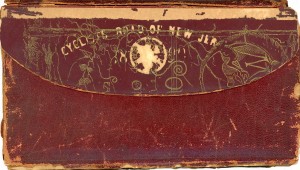Dave Munn was a librarian by training, historian by inclination, and book collector by compulsion, the latter an allurement that has afflicted many. During the early part of his career Dave worked at the New Jersey State Library in the Bureau of Archives and History. He later became Director of the Cherry Hill Public Library, and in the final years of his service as librarian joined the Atlantic County Library System working in Mays Landing and finally as the branch manager in Hammonton. An active historian, he served as President of the Camden County Historical Society and also as chairman of the Gloucester City Historical Preservation Commission. A founding member of the West Jersey History Roundtable, he gathered monthly with local historians and promoted others’ projects as well as pursued his own. He published several works on South Jersey history and edited many others. Collecting New Jersey materials, especially South Jersey materials, was his passion. His gift of over 10,000 titles to Special Collections is especially strong in New Jersey local histories, South Jersey literature (poetry and novels), materials having to do the Lindbergh family, and ephemera.
Dave Munn, good friend of the Stockton community and to all those intrigued by local history, died in mid-April, 2014. Displayed here is a sampling of the material he donated in the hope that it would be used to deepen our enjoyment and understanding of past history. This exhibition is dedicated to his fond memory.
Field Trip to the Burbridge Village Colony Graveyard
William W. Leap is kneeling; David C. Munn is standing at right. Stockton is very fortunate that these two historians chose to donate their extensive collections of South Jersey material to Special Collections, providing students, faculty, and community members with high quality, and sometimes unique materials to study local history and culture. Four other illustrious members of the important and active West Jersey History Round Table accompanied them on this trip.
*
The Grants, Concessions, and Original Constitutions of the Province of New-Jersey. The Acts Passed During the Proprietary Governments, and Other Material Transactions Before the Surrender Thereof to Queen Anne. . . . Philadelphia: W[illiam] Bradford [1758].
This 763 page text, printed by William Bradford, Benjamin Franklin’s chief rival in the Philadelphia printing business, is an important compilation of New Jersey charters and session laws of the proprietary period (1664 to 1702), up to Lord Cornbury’s commission and instructions as Royal Governor, when New Jersey became a crown colony under Queen Anne. The work was the largest volume issued from Bradford’s press and one of the largest from any eighteenth-century American press.
*
Walt Whitman. Whitman Illuminated: Song of Myself. Illustrated by Allen Crawford. Brooklyn, NY: Tin House Books, 2014.
This is an advance sample publication of Allen Crawford’s artistic illumination of Walt Whitman’s “Song of Myself.” Crawford turned the original 60-page poem from Whitman’s 1855 edition into a 234-page work of art. Crawford’s work is dedicated to David C. Munn.
*
Constitution and By-Laws: Chapter No. 1 Ladies’ Auxiliary of the Industrial Union of Marine and Shipbuilding Workers of America, Local No. 1. Adopted, 1939; Amended, 1943. Pp. 12.
*
Henry A. Benedict. The Cyclists’ Road Book of New Jersey, Containing Eight Sectional Maps of New Jersey and a Map of Westchester County, N. Y., Showing All Roads, With Cycling Roads Designated and Classified as to Condition, Quality and Grade. 1890.
*
Herman Knickerbocker Vielé. Myra of the Pines. New York: A. Wessels Co., 1906. Pp. 326.
*
Francis H. Brognard, M. D. Observations on Typhus Fever, Typhus Pneumonia, and Dysentery. Mount-Holly: M’Knight & Felthousen, 1816. Pp. 23.
Charles K. Landis.
*
Carabajal, The Jew: A Legend of Monterey, Mexico. Vineland, NJ: Cloyd & Smith, 1894. Pp. 27.
An intriguing short story written by Charles K. Landis, founder of Vineland, NJ: it details the adventures of Carabajal, governor of Mexico, during that country’s early colonial history.
*
The New-Jersey Apple Girl. New York: Mahlon Day, 1836. Pp. 17.
*
David Young. The Wonderful History of the Morristown Ghost. Newark: Published by Benjamin Olds, 1826. Pp. 76.
*
A. H. Newton. Out of the Briars: An Autobiography and Sketch of the Twenty-Ninth Regiment Connecticut Volunteers. Philadelphia: The A. M. E. Book Concern, 1910.
The memoir of Alexander Herritage Newton details a rich and varied life. Born in 1837 in Craven County, North Carolina, Newton “was born under the regime of slavery, a free child, my mother being a free woman.” As a young man he played a role in the Underground Railroad, helping slaves begin their journey to the North. He left the South in 1857 and settled in Brooklyn. When Abraham Lincoln issued a call for 75,000 troops at the start of the Civil War, Newton was not able to enlist directly. Instead, he joined the Thirteenth Regiment of Brooklyn in a support capacity. After the Emancipation Proclamation, he enlisted in the 29th Connecticut Infantry and served as quartermaster sergeant. He was ordained within the A. M. E. Church after the war, eventually settling in Camden New Jersey. Newton died at 83 years of age in 1921.
*
Elizabeth Collins. Memoirs of Elizabeth Collins, of Upper Evesham, New Jersey, a Minister of the Gospel of Christ, in the Society of Friends. Philadelphia: Uriah Hunt, 1833. Pp. 153.












